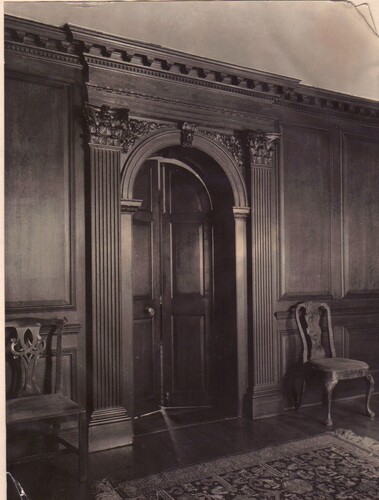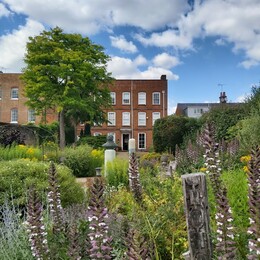News Story
Willmer House, better known today as the Museum of Farnham, is a Grade 1 listed Georgian townhouse which is considered an exceptional example of its type. The building has a rich and varied history of ownership which is just as interesting as the exhibitions within the museum.
As we get ready to commence the vital MEND project restoration of Willmer House this summer, we have a look back at how this beautiful building came into existence and how its expensive construction led to a host of different owners and fascinating stories.
Before Willmer House
The first recorded building on site was 'Arundel's house' built on the land covering the vicinity of 38-40 West Street in the Elizabethan era. After passing through several owners, the house was bought by John Thorne and demolished to make way for his grand design.
John Thorne - the first owner (1718 - 1738)
If you go outside the museum on your next trip, head down Bishop's Mead and look up at the top of the drainpipe on the side of Willmer House where you can just about see the initials J.T and the date 1718. The initials stand for John Thorne, a maltster, hop-merchant and gentleman of Farnham, who the house was built for in 1718.
The property extended all the way back to the 'New Cut' river and stretched from the lane along the east side of the house to the boundary of No. 45. The construction of such a fine brick building was an extravagant display of Thorne's wealth. At the time, Georgian gauged brickwork was the fashion trend of the time and wealthy individuals would often use the brickwork style in window and door surrounds to give a smooth, crisp finish to the property. For the entire front façade to be applied with this finish would have been extraordinary and John Thorne knew this would make an impression in society. However the hop business was always precarious and by 1738 John Thorne had become bankrupted and his assets were seized. 38 West Street was excluded as it was held in trust for his wife and son.
You can see the difference between gauged and regular brickwork by comparing the front and the back of the building.
Image gallery
Slater's House (C. 1756 - 1780)
For some years the house and its accompanying brewhouse, which stood on the site of the 'annexe' (now the museum library and storage rooms) were let on short leases.
By 1756 the house had become known as 'Slater's House', named after the then owner Samuel Slater, brewer and gentleman of Farnham. Samuel sold some of the property's grounds to his neighbour, John Manwaring, reducing the size of the garden significantly. Manwaring, a wealthy hop-merchant, built Sandford House (No. 39 West Street) on the strip of land released.
Willmer House School for Young Ladies (1809-1842)
In 1809 the house was purchased by Anne Willmer and from this point forwards the building became known as 'Willmer House'. It was Miss Willmer's two daughters who set up the school for young ladies which took in nine pupils aged between 10 and 15 years.
Thomas Hunter's School for Boys (1842–1860)
Thomas Hunter had been running a boy's school across the road when he bought the larger Willmer House when it became available in 1842. The census for 1851 lists the occupants of the private boarding school as ten pupils aged between 11 and 18 years.
Willmer House - Private Residence (1860-1876)
Between 1860 and 1876 the house was leased to various owners. In 1866, Mrs Caroline Paine (who also owned Sandford House next door), set about changing the layout of the school back to that of a private house. It is at this point that the old brewhouse between Willmer and Sandford Houses was taken down and the annexe built to provide service accommodation. At the same time the garden wall was raised so that the servants could not see into the neighbouring garden from their quarters.
James Sidney Longhurst - Dentist (1876-1924)
James Sidney Longhurst was a former pupil at Willmer House and used the house as both a home and a dental surgery. His grandson, Mr Willmott Brown, recalled visiting the house in the early 1920's: "The only room in the house that rang with laughter was the nursery over the kitchen, and reached by the back stairs. The big front 'drawing room' was sacrosanct, the panelled dining room rather gloomy, and of course, the surgery was a chamber of horrors." Willmott also mentions that he preferred to come in the backway as... "to come in via the front door would mean disturbing old Baigent, the butler snoozing in his snug little pantry under the fine main staircase."
World War Two - Canadian Army (1939 - 1945)
Following the death of Sidney Herbert Longhurst (son of James), the property was bought by Mrs. Burke. Upon her death in 1939 she left it to her sister Mrs Holmes in Scotland. Mrs. Holmes put the house's contents in storage and offered use of the house to a unit of the Canadian Army stationed in the area during the war.
Willmer House - in public hands (1961 onwards)
After the war, the house was taken on by Waverley Borough Council who converted it into a museum for the town and a library for local studies.
The museum seeks to share Farnham’s history, from its prehistoric roots to its hop growing boom and Georgian grandeur. It is also home to an extensive art and craft collection thanks to the many artists and crafts people who have been drawn to Farnham over the years.
In March 2023 the museum was successfully awarded a grant from Art Council England's Museum Estate and Development Fund (MEND). This award will help us restore the front façade of the building and realise a longer-term ambition of recognising Wilmer House as part of our collection to be shared, explored and preserved for future generations.
You can learn much more about Willmer House on one of the monthly building tours which run on selected Saturdays throughout the summer.





